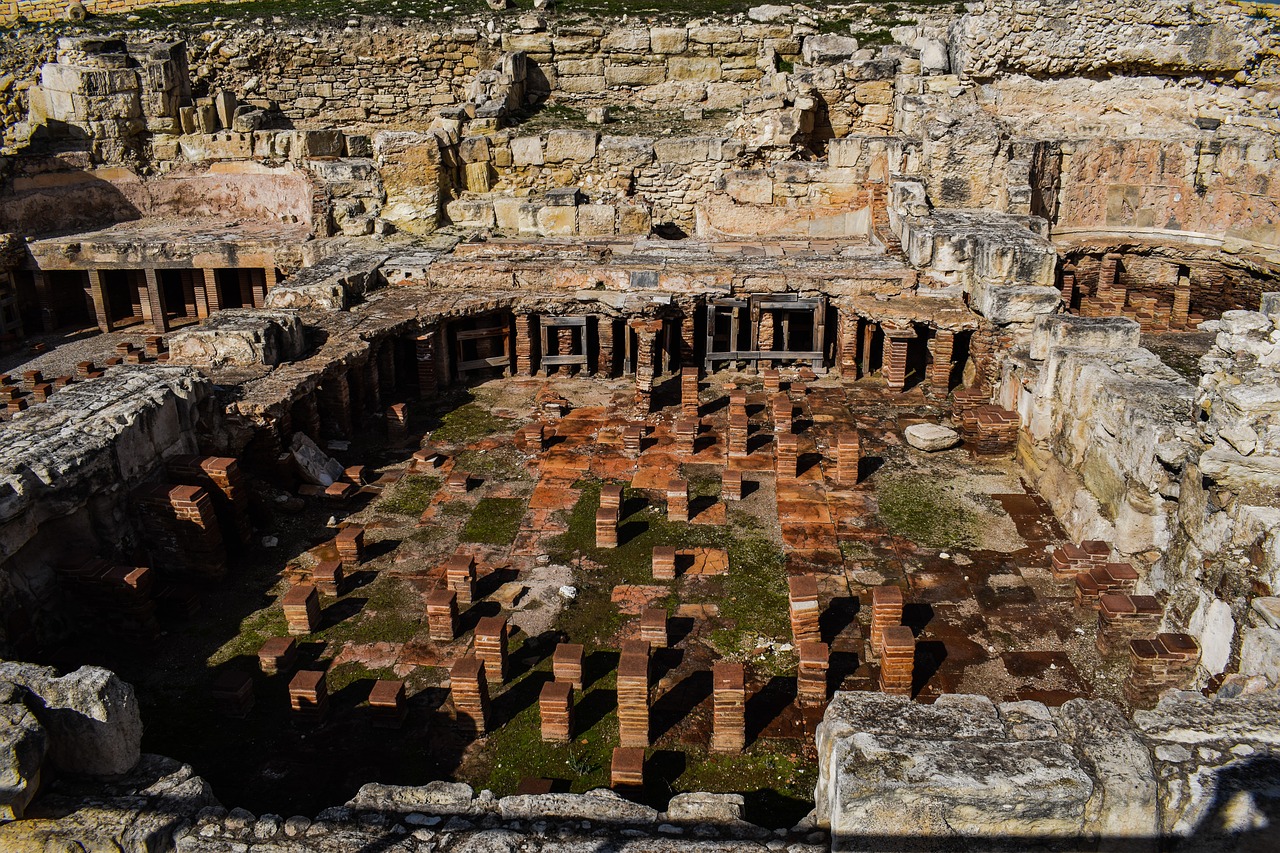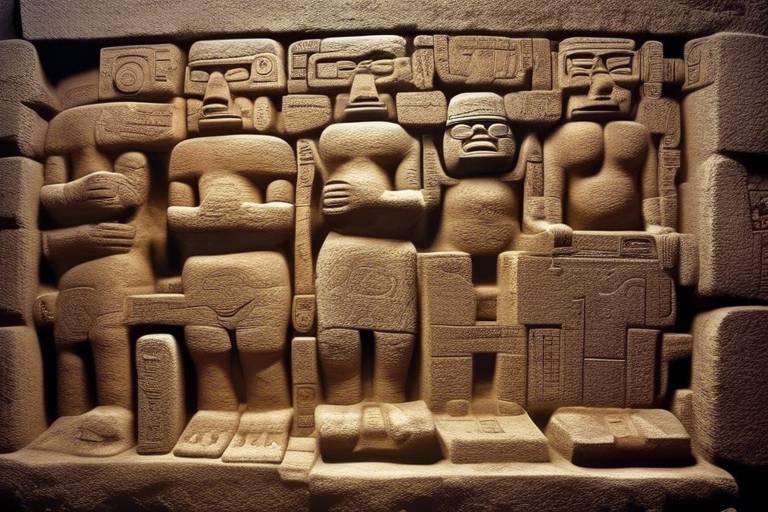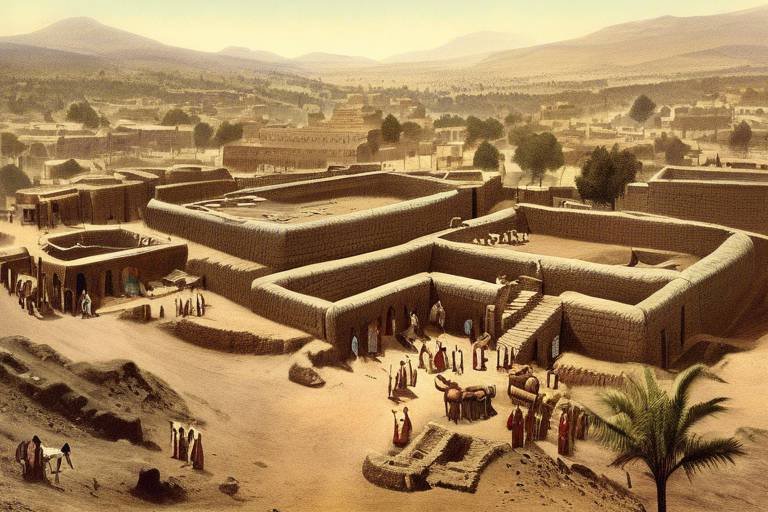Secrets of the Olmec - The First Mesoamerican Civilization
The Olmec civilization, often hailed as the first Mesoamerican culture, holds a plethora of secrets waiting to be unveiled. Their legacy is shrouded in mystery, yet their achievements in art, society, and religion are nothing short of extraordinary. Imagine stepping into a world where colossal stone heads stand as silent sentinels, intricate jade carvings whisper ancient tales, and enigmatic religious practices beckon you to explore further.
As we embark on this journey to uncover the enigmatic origins of the Olmec civilization, we find ourselves immersed in the tropical lowlands of Mexico. Here, amidst lush vegetation and fertile lands, the Olmec thrived with innovative agricultural practices that sustained their burgeoning society. Their iconic ceremonial centers rose like beacons of civilization, showcasing the sophistication of their culture and the depth of their spiritual beliefs.
Delving deeper, we encounter the mesmerizing art and iconography that define the Olmec people. Their monumental sculptures, notably the colossal stone heads, stand as a testament to their artistic prowess and cultural significance. Intricate jade carvings adorned with symbolic motifs reveal a society deeply connected to nature and spirituality, influencing future Mesoamerican cultures in profound ways.
The social structure of the Olmec society unveils a complex web of relationships, hierarchies, and governance. Rulers and elites governed city-states with precision, overseeing specialized labor and intricate trade networks that spanned vast distances. The Olmec society thrived on cooperation, innovation, and a deep-seated respect for tradition and authority.
Step into the spiritual realm of the Olmec, where elaborate rituals, sacred monuments, and revered deities like the Maize God and were-jaguar hold sway. Shamanism played a pivotal role in their religious beliefs, connecting the physical and spiritual worlds in a harmonious dance of cosmic significance. The Olmec's religious practices were deeply intertwined with their daily lives, shaping every aspect of their society.
As we unravel the decline of the Olmec civilization, we confront environmental challenges, political unrest, and the specter of external invasions. The once-mighty empire faced internal conflicts and external pressures that ultimately led to its downfall. Yet, the legacy of the Olmec endures, leaving an indelible mark on Mesoamerican art, architecture, and cultural practices.
Tracing the threads of influence that the Olmec civilization wove through time, we discover their profound impact on subsequent cultures such as the Maya and Aztecs. Their artistry, societal structure, and religious beliefs continue to resonate in the annals of history, reminding us of the enduring legacy of the first Mesoamerican civilization.

Origins of the Olmec
The origins of the Olmec civilization are shrouded in mystery, with scholars still debating the exact beginnings of this ancient culture. Located in the tropical lowlands of Mexico, the Olmec emerged as the first major Mesoamerican civilization around 1400 BCE. Their rise to prominence was marked by innovative agricultural practices that allowed them to support large populations and establish thriving communities.
One of the defining features of the Olmec civilization was the construction of iconic ceremonial centers such as La Venta and San Lorenzo. These monumental sites served as religious and political hubs, showcasing the Olmec's architectural prowess and organizational skills. The layout of these ceremonial centers reflected the Olmec's deep connection to nature and their spiritual beliefs.
Archaeological evidence suggests that the Olmec were skilled artisans, creating intricate jade carvings and pottery adorned with symbolic motifs. The most famous examples of Olmec art are the colossal stone heads, massive sculptures that depict powerful individuals with distinct facial features. These monumental works of art not only showcase the Olmec's artistic talents but also highlight their reverence for rulers and elites within their society.
Moreover, the Olmec's sophisticated iconography, including symbols like the jaguar and the feathered serpent, would later influence the artistic traditions of subsequent Mesoamerican cultures. Their artistic legacy continues to captivate scholars and art enthusiasts alike, shedding light on the rich cultural heritage of the Olmec civilization.

Olmec Art and Iconography
Exploring the mysteries and achievements of the Olmec civilization, considered the mother culture of Mesoamerica, with their advanced art, monumental sculptures, complex society, and enigmatic religious practices.
Unraveling the enigmatic beginnings of the Olmec civilization in the tropical lowlands of Mexico, their innovative agricultural practices, and the establishment of their iconic ceremonial centers.
The Olmec people were renowned for their sophisticated artistry, which left a lasting impact on Mesoamerican cultures. Their art and iconography reflected a deep understanding of symbolism and spirituality. One of the most iconic aspects of Olmec art is the colossal stone heads, massive sculptures that depict powerful individuals with distinct features. These monumental stone heads not only showcase the artistic skill of the Olmec but also serve as a testament to their reverence for rulers and elites.
Moreover, the Olmec excelled in jade carving, creating intricate and detailed figurines and ornaments that displayed their mastery of this precious material. Jade held significant symbolic value for the Olmec, representing fertility, power, and prestige. The use of jade in their art highlighted the Olmec's connection to the natural world and their spiritual beliefs.
Symbolic motifs were prevalent in Olmec art, with recurring themes such as jaguars, serpents, and anthropomorphic figures. These symbols were not merely decorative but held profound meaning in Olmec society, representing deities, natural forces, and cosmic realms. The intricate designs and patterns found in Olmec art served as a visual language, communicating complex ideas and spiritual concepts.
Investigating the social structure of the Olmec society, their hierarchical organization, specialized labor, and the role of rulers and elites in governing their city-states.
Exploring the spiritual world of the Olmec through their elaborate rituals, deities like the Maize God and were-jaguar, sacred monuments, and the significance of shamanism in their culture.
Examining the Olmec's extensive trade networks, the distribution of goods such as jade and obsidian, and the cultural interactions that facilitated the exchange of ideas across Mesoamerica.
Analyzing the factors that led to the decline of the Olmec civilization, including environmental challenges, political instability, and the possible influence of external invasions or internal conflicts.
Tracing the enduring legacy of the Olmec civilization in Mesoamerican art, architecture, religion, and cultural practices, and their profound impact on subsequent civilizations such as the Maya and Aztecs.
Stay tuned for the answers to common questions about the Olmec civilization, their cultural significance, and the legacy they left behind.

Olmec Society and Governance
The Olmec society was a complex and hierarchical structure that played a crucial role in governing their city-states. At the top of the social hierarchy were the rulers and elites who held significant power and influence over the population. These rulers were believed to have been both political and religious leaders, overseeing various aspects of Olmec life.
Specialized labor was a fundamental aspect of Olmec society, with individuals fulfilling specific roles based on their skills and expertise. Artisans, farmers, priests, and warriors all contributed to the functioning of the society, each playing a vital role in maintaining the stability and prosperity of the civilization.
The Olmec society was organized into distinct social classes, with individuals occupying different positions based on their status and responsibilities. The hierarchical structure ensured that power and resources were concentrated among the ruling elite, who wielded authority over the population through a system of governance that emphasized centralized control.
Religious beliefs also played a significant role in Olmec society, with rituals and ceremonies serving as important mechanisms for maintaining social cohesion and reinforcing cultural norms. The Olmecs worshipped a pantheon of deities, including the Maize God and the were-jaguar, whose influence permeated all aspects of daily life.
Moreover, the Olmec society engaged in trade and exchange with neighboring cultures, facilitating the flow of goods and ideas across Mesoamerica. The exchange of commodities such as jade and obsidian allowed the Olmecs to establish connections with distant communities, fostering cultural interactions and mutual influences.
In conclusion, the Olmec society was a sophisticated and organized civilization that thrived in ancient Mesoamerica. Their social structure, governance system, and religious beliefs all contributed to the development and success of their civilization, leaving behind a lasting legacy that continues to fascinate historians and archaeologists to this day.

Olmec Religious Beliefs
The Olmec civilization was deeply rooted in spiritual beliefs and religious practices that shaped their society and culture. At the heart of Olmec religious beliefs were elaborate rituals and ceremonies that honored a pantheon of deities, with the Maize God and the were-jaguar being among the most prominent figures. These deities were often depicted in art and sculpture, symbolizing the Olmec's connection to the divine and the natural world.
Shamanism played a vital role in Olmec religious practices, with shamans acting as intermediaries between the human and spirit realms. Through trance-like states induced by hallucinogenic substances or meditation, shamans communicated with the spirit world to seek guidance, healing, and divine knowledge. The Olmec believed in the power of these spiritual leaders to bridge the gap between mortals and the supernatural.
Sacred monuments, such as the colossal stone heads found at Olmec ceremonial sites, served as focal points for religious ceremonies and offerings. These monumental sculptures were believed to embody the spirits of revered ancestors or deities, acting as guardians of the sacred spaces and conduits for divine energy. The Olmec's reverence for these monumental artworks highlights the importance of ancestral worship and spiritual connection in their religious beliefs.
The Olmec also practiced bloodletting rituals as a way to communicate with the gods and ensure the fertility of the land. Priests and rulers would pierce their tongues, ears, or genitals with stingray spines or obsidian blades, offering their blood as a sacred sacrifice. This act of self-sacrifice was believed to appease the deities and maintain the cosmic balance necessary for agricultural prosperity and societal harmony.
Moreover, the Olmec's religious beliefs were intricately intertwined with their daily lives, influencing everything from agricultural practices to social hierarchies. The spiritual world permeated every aspect of Olmec society, shaping their worldview and guiding their interactions with the natural and supernatural realms. The enigmatic religious practices of the Olmec continue to fascinate scholars and enthusiasts, offering a glimpse into the rich tapestry of Mesoamerican spirituality and belief systems.

Olmec Trade and Exchange
When delving into the realm of Olmec trade and exchange, one cannot overlook the intricate web of commerce that connected this ancient civilization with distant lands. The Olmec's strategic location along the Gulf Coast of Mexico enabled them to establish extensive trade networks that spanned across Mesoamerica, facilitating the exchange of valuable goods and ideas.
Central to Olmec trade was the distribution of prized commodities such as jade and obsidian, which were highly sought after for their symbolic and practical significance. Jade, revered for its mystical properties, was intricately carved by Olmec artisans into exquisite ornaments and ceremonial objects, serving as a symbol of wealth and power within their society.
Moreover, the Olmec's mastery of obsidian, a volcanic glass prized for its sharp cutting edge, allowed them to produce tools and weapons of exceptional quality, which were in high demand among neighboring cultures. This expertise in crafting valuable goods not only fueled the Olmec economy but also solidified their reputation as skilled artisans and traders.
Through their extensive trade networks, the Olmec engaged in cultural exchanges that transcended mere economic transactions. The interactions with neighboring societies not only facilitated the flow of goods but also served as conduits for the dissemination of artistic styles, religious beliefs, and technological innovations.
As the Olmec traded their goods far and wide, they left an indelible mark on the cultural landscape of Mesoamerica, influencing the artistic traditions and economic practices of subsequent civilizations. The legacy of Olmec trade and exchange reverberates through the annals of history, underscoring the pivotal role they played in shaping the interconnected tapestry of ancient Mesoamerican civilizations.

Decline of the Olmec Civilization
As we delve into the intriguing history of the Olmec civilization, we inevitably come face to face with the decline that marked the end of this once-thriving culture. The decline of the Olmec civilization is a complex tapestry woven with various factors that contributed to its eventual unraveling.
One significant element that played a role in the decline of the Olmec civilization was environmental challenges. The lush tropical lowlands that had nurtured the Olmec for centuries began to face ecological stress, possibly due to overexploitation of resources or natural phenomena such as volcanic eruptions or climate change. These environmental pressures could have strained the agricultural productivity and overall sustainability of the Olmec society.
Moreover, political instability within the Olmec city-states likely added to the civilization's downfall. Internal power struggles, conflicts among ruling elites, or challenges to the established social order could have weakened the cohesion of the Olmec society. The lack of a strong centralized authority may have made it difficult to effectively address external threats or internal dissent.
External invasions or conflicts with neighboring cultures may have also played a role in the decline of the Olmec civilization. The Olmec's once-dominant position in Mesoamerica could have attracted the attention of ambitious rivals seeking to expand their influence or control over the region. Military incursions or trade disruptions caused by external forces could have further destabilized the Olmec society.
As the intricate tapestry of the Olmec civilization began to unravel, a combination of environmental challenges, political turmoil, and external pressures led to its gradual decline. The legacy of the Olmec, however, continued to resonate across Mesoamerica, influencing future cultures and leaving behind a rich cultural heritage that endures to this day.

Olmec Legacy and Influence
Tracing the enduring legacy of the Olmec civilization reveals a profound influence that transcended time and borders. The innovative artistic expressions of the Olmec, such as the iconic colossal stone heads, not only captivated the ancient world but also inspired future Mesoamerican cultures. Their intricate jade carvings and symbolic motifs served as a visual language that resonated across generations, influencing the artistic styles of civilizations to come.
Moreover, the Olmec's architectural achievements, including their monumental ceremonial centers and complex urban planning, set a precedent for architectural design in Mesoamerica. The layout of their cities and the construction of pyramids and plazas became a blueprint for subsequent civilizations like the Maya and Aztecs, showcasing the Olmec's enduring impact on urban development in the region.
Religiously, the Olmec's spiritual beliefs and practices left an indelible mark on Mesoamerican culture. The worship of deities such as the Maize God and were-jaguar, as depicted in their sacred monuments and rituals, shaped the religious landscape of Mesoamerica. The significance of shamanism in Olmec society influenced the role of spiritual leaders in later civilizations, highlighting the lasting legacy of Olmec religious traditions.
Furthermore, the Olmec's economic prowess and extensive trade networks paved the way for cultural exchange and economic prosperity in Mesoamerica. The distribution of valuable goods like jade and obsidian facilitated connections between distant regions, fostering a sense of interconnectedness among diverse communities. This legacy of trade and exchange continued to shape the economic landscape of Mesoamerica long after the decline of the Olmec civilization.
Frequently Asked Questions
- What is the significance of the Olmec civilization?
The Olmec civilization is considered the mother culture of Mesoamerica, known for their advanced art, monumental sculptures, and complex society that influenced later civilizations in the region.
- Where did the Olmec civilization originate?
The Olmec civilization emerged in the tropical lowlands of Mexico, where they developed innovative agricultural practices and established iconic ceremonial centers.
- What are some notable achievements of Olmec art?
The Olmec are renowned for their colossal stone heads, intricate jade carvings, and symbolic motifs that had a lasting impact on Mesoamerican artistic traditions.
- How was the Olmec society structured?
The Olmec society had a hierarchical organization with specialized labor, rulers, and elites governing city-states, showcasing a complex social structure.
- What were the religious beliefs of the Olmec people?
The Olmec practiced elaborate rituals, worshipped deities like the Maize God and were-jaguar, and incorporated shamanism into their spiritual practices.
- How did the Olmec engage in trade and exchange?
The Olmec had extensive trade networks, exchanging goods such as jade and obsidian, fostering cultural interactions and the spread of ideas across Mesoamerica.
- What led to the decline of the Olmec civilization?
The decline of the Olmec civilization was influenced by environmental challenges, political instability, and potential external invasions or internal conflicts that impacted their society.
- What is the lasting legacy of the Olmec civilization?
The Olmec left a profound impact on Mesoamerican art, architecture, religion, and cultural practices, influencing subsequent civilizations like the Maya and Aztecs with their innovative achievements.



















